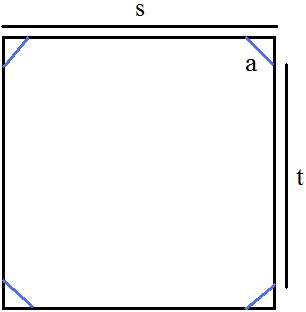Mileage Lost from Cutting Corners
4/16/10
Consider walking a square with side s. The total length walked is then 4s. However, if you cut corners, that is, walk less than s per side by cutting over to the next side diagonally, you walk a distance less than 4s. If this distance is added up over a day, a week, a month, a year, etc., the mileage adds up!
If you cut corners, you go from walking a square to walking essentially an octagon.

The length of a long side of the octagon is
Therefore, the total length walked per lap of the octagon is
Therefore the total difference is length walked between walking a square and walking an octagon is
4s-4t-4a =
4(s-t-a)
Consider a specific example. Say you walk around a parking structure at lunch and s = 100 feet. Say if you do cut, the length of the diagonal walked is a = 15 feet. Therefore, the perimeters are: Perimeter(Square) = 400 and Perimeter(Octagon) = 375, and therefore you lose 25 feet by cutting corners, per lap of the octagon.
However, at lunch you don't just walk one lap, you walk many laps. If you walk 6 laps, every day for 365 days, cutting corners would make you lose 54,428 feet, or 10 miles! Please see this simulation and change the highlighted cells.
However, you don't just exercise for one year and then stop, you exercise for many years. If you keep up the practice of cutting corners for five years you are losing about two marathons! You are exercising, which is good, but you are not getting what you could be getting.
Think of all the other examples where you are cutting corners, either physically or metaphorically, from your exercise and eliminate those practices.
Please anonymously VOTE on the content you have just read:
Like:Dislike: